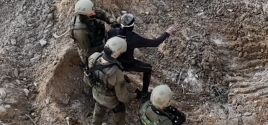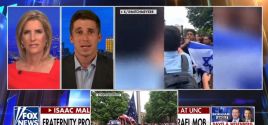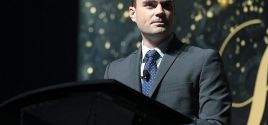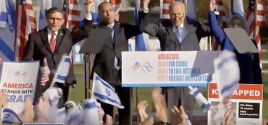'This is America': The Day Police Firebombed West Philadelphiaby William Norman GriggMay. 08, 2015 |
Popular 
Video Shows Israeli Soldiers 'Using Palestinian as a Human Shield'

BlackRock CEO: 'Xenophobic' Countries With Shrinking Populations May Be The 'Big Winners' in AI-Driven Future

"We Were There First and Foremost for Our Country of Israel," UNC Frat Bro Tells Fox News

Report: Daily Wire Got Secret Gag Order Against Candace Owens 'While Publicly Negotiating a Debate'

House Passes 'Antisemitism Awareness Act' to Silence Criticism of Israel as Hate Speech
 By the time Lt. Frank Powell hurled a satchel bomb onto the roof of a three-story row house on Philadelphia’s Osage Avenue, the siege had gone on for nearly twelve hours. Powell was a member of the Philadelphia PD’s bomb squad, and like the “firemen” in Ray Bradbury’s dystopian novelette, he was performing a function assumed to be the opposite of his expected role: Rather than disposing of a military-grade bomb, he was using it as a weapon of mass destruction. The building targeted by Powell was occupied by members of a militant group called The MOVE. Aerial photographs taken shortly before the May 13, 1985 assault displayed a weapons bunker and large containers of oil on the roof of the row house. So it wasn’t at all surprising that a few seconds after Powell heaved his bomb from the open door of a State Police helicopter, a huge orange fireball erupted from the top of the building. The uncontained fire consumed that house and sixty others, leaving the entire neighborhood a smoldering ruin. Philadelphia was the only U.S. city to be bombed from the air during the Cold War, and the perpetrator of that attack was not the Soviet Union, the Weather Underground, or some other offshoot of the Soviet-inspired “Tricontinental Movement.” The perpetrators of this act of mass terrorism was the Philadelphia PD – with the indispensable help of the FBI and the US military. Democratic Representative Bob Brady, who at the time of the siege was a deputy mayor, recalls seeing “All these military men giving advice” during a planning session in Mayor Wilson Goode’s office. “I thought it would be a good idea if we got a boom crane to knock that bunker off,” he recounted. “But somebody above my pay scale decided against it.” That official was City Managing Director Leo Brooks, a retired brigadier general who approved of the plan and observed the bombing from the ninth floor balcony of a nearby geriatric center. Police Commissioner Gregore Sambor, another retired military officer who, according to the son of long-time Philadelphia Mayor Frank Rizzo, “ran around in fatigues,” later testified that bombing the house “was selected as a conservative and safe approach to what I perceived as a tactical necessity.” If the bomb hadn’t been dropped from a helicopter, Sambor insisted, “the perception of that action would have been quite different.” The fire rises: Detonation of the FBI-provided bomb. The only mistake the police made in fire-bombing that residence, apparently, was to get the “opticals” wrong. This decision was not a matter of hasty, desperate improvisation, but rather of careful planning and premeditation. Prior to the May 13 assault, and without a formal request by the city’s “civilian” government, Special Agent Michael Macys of the Philadelphia FBI office provided the police bomb squad with 30 blocks of C-4 explosive and several sticks of Tovex. The latter is the same high-yield explosive provided to Timothy McVeigh by an FBI asset in order to build the Oklahoma City bomb almost exactly ten years later. Reasonable people would be justified in the suspicion that use of the satchel bomb was the preferred option, rather than a fallback plan. At the time of the detonation, Ramona Africa, a former paralegal who had become one of the most prominent and forceful representatives of MOVE, was hiding in the basement along with several children. They had sought refuge there after the police onslaught began, as Lt. Powell and his Bomb Squad comrades used small charges to blow holes in the wall in order to inject tear gas into the dwelling. “Attention, MOVE – this is America,” declared Police Commissioner Sambor by way of a loudspeaker as the attack began. “You have to abide by the laws and rules of America.” “We was in the cellar for a while … and tear gas started coming in and we got the blankets,” recalled survivor Michael Moses Ward (who at the time of the events was known as Birdie Africa). “And we put them over our heads and started laying down.” That strategy proved useless after the bomb went off, creating a fire that burned at an estimated 2,000 degrees Fahrenheit. Police and fire department officials later claimed that the original plan was to use tear gas and “deluge guns” – high-volume fire hoses – to force the occupants out of the abandoned house pursuant to an eviction order and several arrest warrants on a variety of misdemeanor charges. Shortly after the first phase of the operation began, the sound of gunfire caused firefighters to scatter. Within the next ninety minutes, roughly 500 police officers would fire more than 10,000 rounds of ammunition into the dwelling. Another fusillade was unleashed after the bomb went off and people attempted to flee from the burning building. “Come out, come out,” whispered WCAU-TV photographer Peter Kane, horror-struck as he watched the fire from a nearby house he had staked out the previous evening. He wasn’t aware that a “tactical” order had been issued to “let the bunker burn.” Nor was he aware that police officers – some of them wielding machine guns, others armed with silenced sniper rifles – had opened fire on MOVE members trying to escape the flames. Police officials claimed the use of overwhelming force was necessary because the MOVE possessed a vast “arsenal” that included automatic weapons. A search of the rubble turned up a total of four firearms, none of which was a machine gun. During a subsequent investigative hearing, Officer William Stewart reported that he heard “automatic weapons fire” as MOVE members tried to escape the holocaust. When asked who was pulling the triggers, Stewart replied: “Police officers. All the stakeout officers were running into the alley. They all had Uzi machine guns.” This account was corroborated by Officer James D’Ulisse of the Philadelphia PD, and John Vaccarelli and Joseph Murray of the City Fire Department. Eleven people were killed as a result of the bombing. Six of them – including five children -- were cut down by gunfire as they fled the burning building. During a press conference held the evening of the fire, Mayor Goode said he was “fully accountable” for what had happened that day, pointedly exonerating his subordinates. Ten months later a special investigative commission described the bombing as “unconscionable.” Mayor Goode was elected to a second term. None of the police officials involved in the atrocity was charged with a crime or subjected to administrative discipline. Four years after the bombing, FBI Special Agent Macys was suspended for thirty days – not for the unauthorized and illegal transfer of explosives, but for his “evaluation of the FBI’s liability” in the matter, according to contemporaneous press accounts. The only person who endured punishment of any kind in this affair was Ramona Africa, who was convicted of “riot” and “conspiracy.” She spent seven years in prison convalescing from the burns she endured while rescuing Birdie Africa, the only child to survive the firebombing. Following her release, Ramona received a $500,000 civil judgment from the city – after every officer and policy-maker involved in the bombing had been granted “qualified immunity” against personal liability. Rather than treating the incident as a tragic mistake or an act of criminal negligence, the FBI apparently used it to beta-test tactics later employed against “extremists” of different varieties. During the August 1992 siege at Ruby Ridge, Idaho, eyewitnesses and a TV camera crew saw an FBI helicopter take off carrying a large incendiary bomb that would have annihilated the Weaver family’s pathetic dwelling and cremated the troublesome people residing therein. The April 19, 1993 assault by the FBI and Delta Force against the Branch Davidians involved tactics quite similar to those that had been employed against the MOVE, and ended with paramilitary operators directing automatic weapons fire into the flames to deter, or kill, anyone seeking to escape. As was the case at Ruby Ridge and Waco, the group targeted on Osage Avenue consisted of socially marginal people who espoused peculiar religious views. Unlike the Weavers or the Branch Davidians, the MOVE lived in the middle of an urban neighborhood and had managed to alienate everyone living nearby. Founded by a grade school dropout named Vincent Leapheart who renamed himself John Africa, the MOVE combined a primitivist ideology akin to that of Earth First! with the public relations sensibility of the Westboro Baptist Church. Calling the group a cult is descriptive, rather than pejorative: Its members severed ties with the outside world, changed their surnames to “Africa,” and subscribed to a totalistic worldview in which John Africa was seen as a Christ figure. The MOVE’s doctrinaire aversion to hygiene and its insistence on sharing living quarters with animals turned the home they occupied into a reeking, decaying sty. Seen as “revolutionaries” and “terrorists” by the city government, the MOVE experienced countless run-ins with the police. One of them led to a violent arrest in which a newborn baby was killed. By 1976, the group’s commune in Powelton Village was under 24-hour police surveillance. An eviction order was issued in August 1978, leading to a shoot-out during which a police officer James Ramp was killed. “Did the MOVE members shoot Ramp?” comments former Philadelphia City Councilman Angel Ortiz. “This has never been fully answered. The MOVE compound was razed without proper forensic analysis.” Nine MOVE adherents were convicted of murder in the killing of James Ramp. None was specifically identified as the shooter, and it’s not clear how nine people shared responsibility for a single fatal gunshot. For the next seven years, after the MOVE migrated to Osage Avenue and took control of a large abandoned house, the group continued to accumulate citations and provoke complaints from their neighbors, most of whom were middle-class blacks. Neighbors who could tolerate the olfactory onslaught from the group’s living area found it more difficult to endure incessant – and frequently profane --harangues broadcast by the MOVE via loudspeaker, many of which demanded the release of their imprisoned comrades. On May 12, 1985 – Mother’s Day – people living near the targeted building were ordered to evacuate as police made preparations for the pre-dawn attack. By the end of the following day, hundreds of local residents were homeless as a result of the bombing. If the purpose of the exercise had been simply to evict the MOVE, the police could simply have cut off electricity and water and waited for the group to leave. “Why don’t they just back up and relax?” asked State Senator Hardy Williams as he watched the siege unfold. “Nobody’s going anywhere.” An approach of that kind would have solved the problem, but not inflicted punishment on a group seen by the police as a tribal enemy, and resented by the municipal government for defying its authority. The Philadelphia PD, which may be the most violence-prone municipal police agency in the country, wanted a measure of revenge for the death of Officer Ramp (a message inscribed on a locker room chalkboard and left there for years read “MOVE 1, PPD 0”). That sentiment was fortified when Mumia Abu-Jamal, a radical activist sentenced to death for the murder of Philadelphia PD officer Daniel Faulkner, became a prominent admirer of the group. Leo Brooks, the impenitent official who devised the aerial assault plan, blithely described the wholesale annihilation of an entire city block as the kind of things that happen “when citizens failed to abide by the law and respond to the police authority.” The compelling need to assert that “authority” supposedly justified the criminal actions of police officials and the indiscriminate destruction of the homes and property of people who had nothing to do with the group. "They won't be calling the Police Commissioner `Motherf****r' anymore," gloated one Philadelphia cop after the neighborhood had been burned down. Philadelphia radio host Michael Coard contends, plausibly, that the police bombing “never would have happened in the Northeast or in South Philly, even if the Hell’s Angels had kidnapped then-President Ronald Reagan. And everybody knows it…. G**dammit, even Osama’s house and neighborhood in Abbottabad weren’t firebombed.” Thirty years later, the neighborhood bears the ineffaceable scars inscribed through this exercise in state terrorism. As it happened, I was in Philadelphia on the morning of May 13, 1985 as part of a college performing group. By the time we departed for our next engagement, the assault had already begun, and we heard news of a “shoot-out” shortly before our arrival in Washington, D.C. As we retired that evening, the local television news carried accounts of the firebombing – which commanded less attention than another debacle that took place on the same day, the introduction of the “New Coke” in an event at Lafayette Park. The Coca-Cola Company’s ill-advised decision to alter the formula of its toxic soft drink caused a paroxysm of national outrage on the part of a public that reacted to the Philadelphia fire-bombing with stolid indifference. Those who tampered with that product faced accountability. Jobs were lost, reputations were ruined, and corporate policies were changed. Nothing of the sort befell those responsible for a military assault on an urban neighborhood that left nearly a dozen people dead and hundreds of people homeless. Coca-Cola’s decision to change its recipe was national news, as was the company’s chastened decision to rescind that change. The fire-bombing of West Philly received perfunctory notice in the State-aligned media, and was quickly forgotten by a materially sated population. As Commissioner Sambor said in his overture to the holocaust on Osage Avenue, “This is America” – or, in any case, what we’ve allowed it to become. |



